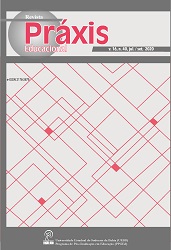EL DERECHO AL JUEGO: UNA NECESIDAD PARA LOS NIÑOS, UN POTENCIAL PARA LA ESCUELA Y LA CIUDAD
DOI:
https://doi.org/10.22481/praxisedu.v16i40.6899Palabras clave:
Ciudad, Derecho al juego, Escuela, NiñosResumen
La pregunta principal que se aborda en este artículo es: ¿por qué y cómo se debe considerar el juego infantil un parámetro importante en las políticas urbanas? Una posible respuesta a este problema se encuentra en todo el texto. Me gustaría comenzar dibujando la evolución más reciente (o más bien involucionada) de la estructura y organización urbana, haciendo hincapié en cómo define un entorno que está prohibido y hostil a los niños, a menos que vayan acompañados de adultos; Resumiré el impacto de este entorno en el juego y, por lo tanto, en el desarrollo de los niños, acentuando las diferentes características de la movilidad espacial en niños y adultos, y el peligro extremo de aislar a los niños de la experiencia del peligro. Propondré una alternativa radical a la política urbana en la que los niños y su juego sean el foco principal, más que un problema marginal y no se sepa que sólo se considere como una reflexión posterior, y presentaré algunos casos concretos en aquellos en los que los niños y los políticos pusieron en práctica una alternativa de este tipo, y sus efectos fueron probados y evaluados. En conclusión, experiencias similares parecen justificar una cantidad moderada de esperanza para el futuro de nuestras ciudades, a pesar de sus preocupantes condiciones actuales.
Descargas
Citas
BARALDI, C., MAGGIONI, G.(eds.). Una città con i bambini, progetti ed esperienze del Laboratorio di Fano, Roma: Donzelli Editore, 2000.
BATESON, G., The Message “This Is Play”, New York: Josiah Macy Jr. Foundation, 1956.
BAUMAN, Z., The individualized society, Cambridge: Polity Press, 2001.
BENCIVENGA, E. Giocare per forza. Critica alla società del divertimento, Milano: Mondadori, 1995.
BENCIVENGA, E. Tre dialoghi, Torino: Bollati Boringhieri, 1988.
BLAKELY, K. S. ‘Parents’ conceptions of social dangers to children in the urban environment’ Children’s Environments 11, 1994. p. 16-25.
BOZZO, L. ‘Il gioco e la città’, Paesaggio urbano 2, 1995, p. 30-33.
BRUNER, J. S. ‘Nature and uses of immaturity’, in J. S. Bruner, A. Jolly, K. Silva (eds.), Play. Its role in development and evolution, New York: Basic Books, 1976.
CAILLOIS, R. Les jeux et les hommes, Paris: Gallimard, 1967.
CHAWLA, L. Growing up in an urbanizing world, Paris/London: Unesco Publishing/Earthscan, 2001.
DE SAINT-EXUPÉRY, A. Le Petit Prince, Paris: Gallimard, 1943.
GARLING, T., VALSINER, J. (eds.): Children within environment: Toward a psychology of accident prevention, New York: Plenum Press, 1985.
GARVEY, C. Play, Cambridge: Harvard University Press, 1977.
GERMANOS, D. ‘La relation de l'enfant à l'espace urbain: perspectives educatives et culturelles’, Architecture & Comportement 2, 1995, p. 54-63.
GOMBRICH, E. H. Meditations on a hobby horse and other essays on the theory of art, London: Phaidon, 1971.
HART, R. Children’s Participation: The Theory and Practice of Involving Young Citizens in Community Development and Environmental Care, London: Earthscan Publication Limited, 1997.
HILLMAN, M. (ed.). Children, transport and the quality of life, London: Policy Studies Institute, 1993.
HUIZINGA, J. Homo Ludens, Amsterdam: Panteon Verlag, 1939.
KLINE, S. ‘The promotion and marketing of toys: Time to rethink the paradox?’. In: PELLEGRINI, A. The future of play theory, Albany: State of New York University Press, 1995.
LOCKE, J. Some thoughts concerning education, Indianapolis/Cambridge: Hackett Publishing Company (orig. ed. 1693), 1996.
LYNCH, K. ‘The Spatial World of the child’, in W. Michelson, S.V. Levine, E. Michelson (eds.), The child in the city: Today and tomorrow, Toronto: Univerity of Toronto Press.
MANN, M. Incoherent empire, London: Verso Books, 1979/2003.
MARILLAUD, J. ‘Jeu et securité dans l'espace pubblic’, Architecture & Comportement 7, 1991, p. 137-145.
MUMFORD, L. ‘La pianificazione per le diverse fasi della vita’, Urbanistica 1, 1945, p. 7-11.
PIAGET, J. La formation du symbole chez l’enfant, Neuchâtel: Delachaux et Niestlé, 1945.
PREZZA, M., ALPARONE, F. R., RENZI, D., PIETROBONO, A. Social Participation and Independent Mobility in Children: The Effects of Two Implementations of ‘‘We Go to School Alone’’, Journal of Prevention & Intervention in the Community, 38, 2010, p. 8–25.
PREZZA, M., PILLONI, S., MORABITO, C., SERSANTE, C., ALPARONE, F. R. ‘La mobilità autonoma dei bambini nel contesto urbano e il cortile, il parco e la strada privata come spazi di gioco’, Psicologia della salute 3, 2000, p. 81-97.
RISSOTTO, A., TONUCCI, F. ‘Freedom of Movement and Environmental Knowledge in Elementary School Children’, Journal of Environmental Psychology 22, 2002, p. 65-77.
SHAW, B., WATSON, B., FRAUENDIENST, B., REDECKER, A., JONES, T., HILLMAN, M. Children’s independent mobility: a comparative study in England and Germany (1971 - 2010), London: Policy Studies Institute, 2013.
SPINKA, M., NEWBERRY, R. C., BEKOFF, M. ‘Mammalian play: Training for the unexpected’, Quarterly Review of Biology 76, 2001, p. 141-168.
SUTTON-SMITH, B. The ambiguity of play, Cambridge: Cambridge University Press, 1997.
SUTTON-SMITH, B. Toys as culture, New York: Gardner Press, 1986.
TAYLOR, A . F., WILEY, A., KUO, F. E., SULLIVAN, W. C. ‘Growing up in the Inner City: Green Spaces as Places to Grow’ Environment and Behavior 30, 1998, p. 3-27.
TONUCCI, F. La città dei bambini, Bari: Laterza, 1996.
TONUCCI, F. Se i bambini dicono: adesso basta!, Bari: Laterza, 2002.
TONUCCI, F., RISSOTTO, A., ‘Why Do We Need Children's Participation? The Importance of Children's Participation in Changing The City’, Journal of Community and Applied Social Psychology 11, 2001, p. 407-419.
VYGOTSKY, L. S. ‘Play and its role in the mental development of the child’, Soviet Psychology 12, VI, 1966.
Descargas
Publicado
Número
Sección
Licencia
Você é livre para:
Compartilhar - copia e redistribui o material em qualquer meio ou formato; Adapte - remixe, transforme e construa a partir do material para qualquer propósito, mesmo comercialmente. Esta licença é aceitável para Obras Culturais Livres. O licenciante não pode revogar essas liberdades, desde que você siga os termos da licença.
Sob os seguintes termos:
Atribuição - você deve dar o crédito apropriado, fornecer um link para a licença e indicar se alguma alteração foi feita. Você pode fazer isso de qualquer maneira razoável, mas não de uma forma que sugira que você ou seu uso seja aprovado pelo licenciante.
Não há restrições adicionais - Você não pode aplicar termos legais ou medidas tecnológicas que restrinjam legalmente outros para fazer qualquer uso permitido pela licença.












